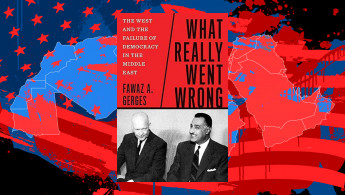Fawaz Gerges' What Really Went Wrong examines what the Middle East would have looked like if the US acted differently in the 1950s
Iran's Mohammad Mosaddegh and Egypt's Gamal Abdel Nasser belonged to different generations. By the time Nasser was born, Mossadegh had already become the first Iranian to receive a doctorate in law from a European university.
However, the differences between these two leaders went beyond their generations. Mossadegh, a democrat, was overthrown by the military in 1953, only two years after becoming Iran's prime minister. In contrast, Nasser, a military officer, took control from his fellow army leaders in 1954, eventually becoming Egypt’s prime minister and later president. He stayed in power until his death in 1970.
Despite these contrasts, Mossadegh and Nasser faced similar challenges as leaders of their respective countries in the Middle East during the 1950s. Both were politically independent but faced the daunting task of lifting millions of citizens out of poverty. This task was nearly impossible as long as their key sources of revenue — oil reserves in Iran and the Suez Canal in Egypt — remained under British control.
For Mossadegh and Nasser, France and Great Britain were seen as irredeemable colonial powers, while Russia had also exerted imperial influence over northern Iran. In contrast, the United States (US) lacked a history of imperialism in the region, presenting Washington with a unique opportunity to become the partner of choice for Middle Eastern countries.
Both leaders initially viewed economic cooperation with the US favourably, seeing it as a potential alternative to the old colonial powers. However, this opportunity was ultimately wasted when Washington began interfering in the region's internal affairs in a neo-imperial manner during the 1950s, alienating potential allies like Mossadegh and Nasser.
According to Fawaz Gerges, the author of What Really Went Wrong and Professor of International Relations at the London School of Economics and Political Science, US interference has impeded political development and slowed social change in the region.
US interference in the Middle East
Gerges justifies his focus on Iran and Egypt, two of the most populous countries in the Middle East, alongside Turkey. He emphasises their pivotal roles, noting that Egypt was particularly significant due to Nasser's pan-Arab influence. US interference in Iran and Egypt during the early Cold War set a dangerous path dependency that later reappeared in conflicts in Afghanistan and Iraq.
The title of Gerges' book directly responds to Bernard Lewis' What Went Wrong? The Clash Between Islam and Modernity in the Middle East, published in 2002. Lewis argued that the political and economic backwardness of Islam and the Middle East was self-inflicted.
His influence extended beyond academia, reportedly reaching White House and Pentagon officials involved in planning the 2003 invasion of Iraq. Although Edward Said and Bernard Lewis had a long-standing intellectual (and possibly personal) rivalry, Gerges does not directly challenge Lewis's arguments. Instead, he uses them as a backdrop to present an alternative account of the Middle East's recent history.
The struggle for autonomy in a Cold War era
Gerges argues that the future of the Middle East was relatively open in the early 1950s. However, the emergence of the US as a superpower alongside the Soviet Union significantly constrained these possibilities, with consequences that are still evident today.
During the Cold War, Washington’s rigid binary mindset offered no middle ground between Western capitalism and Soviet communism. Leaders who sought non-alignment were often dismissed by the US as covert communists. This approach revealed a lack of understanding of the Middle Eastern context, where newly independent leaders were wary of aligning with any external power again.
According to Gerges, some US diplomats on the ground understood the situation well and urged caution. However, their messages went unheard in Washington. The situation deteriorated further when President Eisenhower succeeded Truman in 1953 and appointed the staunch Cold War advocates, brothers Allen Dulles and John Foster Dulles, as CIA director and Secretary of State, respectively.
After Mossadegh nationalised Iran's oil industry in 1951, the British responded with a boycott on Iranian oil. As Gerges explains, "For Mossadegh, the struggle for oil was a symbol of the country's struggle for sovereignty and the way to development and the eradication of poverty." Mossadegh rejected proposals from London and Washington to resolve the oil crisis because they did not acknowledge Iran's ownership of its oil.
Initially sceptical, the US — especially under Eisenhower — began to support British plans to overthrow Mossadegh and regain control of Iran's oil industry. The British capitalised on the anti-Communist sentiment in Washington by arguing that deposing Mossadegh would keep Middle Eastern oil in Western hands and prevent a takeover by the Iranian communists, the Tudeh Party.
In reality, the Tudeh Party lacked the power to force Mossadegh's hand toward Communism. However, perception was more important than reality, and the US decided that Mossadegh had to be removed. After the Iranian government expelled British diplomats, the US took control of the coup planning. Using generous bribes, CIA operatives coordinated with Iranian clerics and military figures opposed to Mossadegh, removing him by force in August 1953.
At that time, tensions between Egypt and the US had not yet fully developed. In September 1955, after failing to reach a similar deal with the US, Nasser began receiving weapons from the Soviet Union through Czechoslovakia. The Soviet-Egyptian arms deal escalated tensions between Cairo and Washington.
Nonetheless, the US, along with Britain and the World Bank, offered Egypt $70 million in economic aid to build the Aswan High Dam. This massive infrastructure project was crucial for controlling the flow of the Nile and would pave the way for hydroelectric power and Egypt's industrialisation.
Ultimately, Egypt and the US could not agree on funding the Aswan High Dam. The main sticking point was similar to that of the failed arms deal. The Eisenhower administration insisted that any agreement required Nasser to "sign a peace treaty with Israel and join America's global struggle against the Soviet Union," Gerges notes.
Despite Nasser's evident lack of sympathy for Communism, demonstrated by his repression of Egyptian communists, the US demanded full alignment with Washington's foreign policy. Nasser was unwilling to compromise Egypt's independence in its foreign affairs.
After negotiations with the US broke down, Nasser secured a loan from the Soviets in 1956 at a 2% interest rate to fund the Aswan High Dam. To repay the loan, Nasser nationalised the Suez Canal, previously controlled by the British.
In response, France, Britain, and Israel launched a military intervention in October 1956 to occupy the Sinai Peninsula and wrest control of the Suez Canal from Egyptian hands.
Impact of US actions on Middle Eastern development
The tripartite alliance ended its military offensive when the US threatened sanctions. Despite Washington's crucial role in halting the aggression against Egypt, US-Egyptian relations did not improve following the Suez Crisis.
Shortly afterward, the US introduced the Eisenhower Doctrine, which justified military interventions abroad to counter communism or perceived communist influence. This policy further diminished the chances of agreements between the US and non-aligned countries.
In What Really Went Wrong, Gerges explores what the future of the Middle East, particularly Egypt and Iran, could have looked like if the US had acted differently in the 1950s.
While some of Gerges' visions are speculative — for example, suggesting that Egypt, along with Iraq, Syria, and Lebanon, could have become the Four Arab Tigers akin to the Four Asian Tigers of Hong Kong, Singapore, South Korea, and Taiwan — his central argument remains persuasive.
US intervention in the 1950s was a pivotal moment as Middle Eastern countries, emerging from colonial rule, sought economic independence and political autonomy. Instead, the US pursued a self-serving ideological agenda.
This maximalist approach turned the US into a major obstacle to the independent economic development that many countries preferred. Allowing these non-aligned nations to pursue their own developmental paths could have gradually strengthened the legitimacy of more representative forms of government.
Marc Martorell Junyent is a graduate of International Relations and holds an MA in Comparative and Middle East Politics and Society from the University of Tübingen (Germany). He has been published in Responsible Statecraft, Jacobin, Inkstick Media, and Democracy in Exile
Follow him on X: @MarcMartorell3





 Follow the Middle East's top stories in English at The New Arab on Google News
Follow the Middle East's top stories in English at The New Arab on Google News


